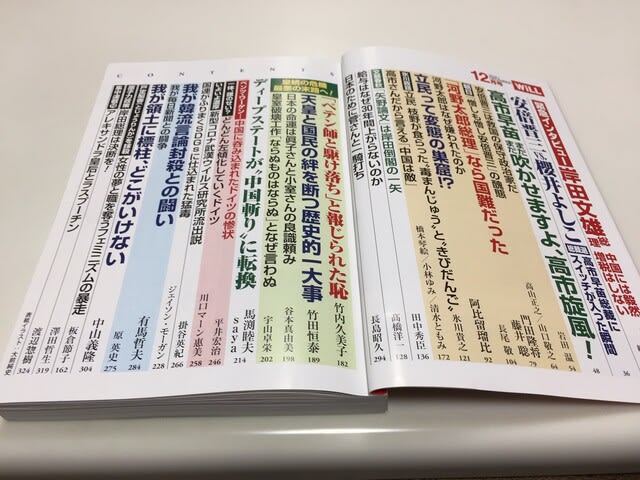The following is from an article by Tetsuo Sawada, assistant professor at the Zero Carbon Energy Institute of the Tokyo Institute of Technology, which appeared in the October 26 issue of the monthly magazine WiLL under the title "Prime Minister Kishida Must Decide on Nuclear Policy!"
It is a must-read not only for the Japanese people but also for people around the world.
The monthly magazine I have been referring to is full of genuine papers by real scholars.
And yet, it is only 950 yen (tax included).
Every Japanese citizen who can read must go to a bookstore to subscribe.
There are still people who subscribe to the Asahi Shimbun and other newspapers.
They pay about 5,000 yen a month to read articles by people striving to undermine Japan, avenge Japan, and degrade Japan's national strength, as Yuzuru Tsuboi embodies.
(Emphasis in the text is mine, except for the headline.
As electric power is the "blood" of the economy, making renewable energy the primary power source would be suicidal.
Suicide of a Nobel laureate in physics
On October 6, the world was excited to learn that Dr. Yoshiro Manabe had won the Nobel Prize in Physics.
Dr. Manabe's work in computer modeling the complex system of climate change is impressive.
But does meteorology belong in the category of physics?
As if to confirm this question, some people are praising the courage of the selection committee in going beyond the field of physics to award the prize.
Even more troubling is the following paragraph in the Nobel Prize Committee's announcement of the reason for the award.
"Without soberly probing the origins of variability we cannot understand the behavior of any system. Therefore, only after having considered these origins do we understand that global warming is real and attributable to our own activities, that a vast array of the phenomena we observe in nature emerge from an underlying disorder, and that embracing the noise and uncertainly is an essential step on the road towards predictability."
The underlined parts translate as follows: 1) Global warming is real. 2) Our own activities cause it.
However, this message is highly political.
There is deep-rooted skepticism or denial among scholars about both (1) and (2).
However, what was revealed in this text was the intention of pretending to the 2021 Nobel Prize in Physics to contain skepticism.
If there is a political gimmick, the Nobel Prize in Physics has chosen the path of suicide.
The following day, October 7, Google announced that it would begin banning advertisements for climate-change-denying content (such as YouTube videos) in November.
The timing is so exquisite that it makes one wonder if Google and the Nobel Prize Selection Committee work together to contain global warming skepticism.
Such a trend can be traced back to Al Gore's winning the Nobel Peace Prize in 2007.
Thirteen years later, in 2020, the Kan administration of Japan announced a plan to become carbon neutral by 2050.
If we don't, we will have frequent power outages.
The Sixth Basic Energy Plan, which is currently being formulated, has not been approved by the Cabinet due to the overly aggressive policy guidance of the Kono-Koizumi (K.K.) duo and the revelation of a scandal involving both K.K.s' renewable energy interests.
Both KKs are adamant about the goal of 100% renewable energy in the future.
Wind power generation is unrealistic in Japan because of poor wind conditions and few suitable sites, and the cost of relying on offshore power generation would be abnormally high.
Therefore, if Japan were to go 100% renewable energy, it would have to move toward laying solar panels all over the country.
Incidentally, according to an estimate by Taku Yamamoto, a member of the House of Representatives, who recently submitted an open letter of inquiry to the Minister of the Environment Koizumi, the area needed to cover all the current fossil fuel power generation with solar power would be equivalent to about 130,000 Tokyo Domes.
If we simply divide this figure, we would need to secure land equivalent to about 2,700 Tokyo Domes in each prefecture.
It is an unbelievable number.
The framework of the Sixth Basic Energy Plan is shown in the figure on the right.
The 36% to 38% of renewable energy includes hydroelectric power (about 10%) and biomass (about 5%), which are stable sources, but the total of solar power and wind power, unstable sources that fluctuate, exceeds 20%.
Twenty percent means that we are truly entering dangerous territory.
When the percentage of variable renewable energy sources, i.e., wind and solar power, exceeds 20%, they become extremely unstable under short-term weather conditions (long rains, heatwaves, no wind, cold waves, etc.) and cause frequent power outages.
I have explained this in detail in my book "Zero Nuclear Power Plants: What We Must Not Do" (Energy Forum).
Recently, China has been experiencing frequent large-scale power outages, and natural gas prices have skyrocketed in Europe, so the world is facing an energy crisis.
China's Xi Jinping regime has issued an order to power plants around the country to curb C0₂ emissions.
It seems that the intention was to show the world China's desire to decarbonize.
As a result, coal-fired power plants, which account for about 70% of the country's power supply mix, have been forced to shut down one after another, and severe power shortages affect two-thirds of the country.
The effects have been enormous:
- Factories have been forced to shut down across the board.
- Power and water outages have been frequent everywhere.
- Traffic lights have gone out, causing massive traffic jams.
- The daily lives of the people have been thrown into chaos.
It is not a temporary situation, and power outages will become the norm in China in the future.
This September in the U.K., the weather was hotter than usual, and there was no wind. As a result, wind power generation did not function adequately, and natural gas power generation made up for the shortage.
European countries are also switching from coal-fired power to natural gas-fired power, which emits less carbon dioxide.
These circumstances have led to a sharp rise in the price of natural gas, leading to higher electricity prices.
As a result, there is a fear that the economy will stagnate, and we are faced with the difficulty of reconciling decarbonization efforts with the economic boom.
The rapid decarbonization and dependence on renewable energy will have a profound impact on industry and people's daily lives.
Nuclear power to 40% or more
I have argued at every opportunity that an industrialized country like Japan should emulate Sweden in terms of its power source composition (December 2020 issue of this magazine).
The actual figures for 2019 are 38% nuclear, 40% hydro, 12% wind, 7% other renewable energies (solar, biomass, etc.), 2% fossil fuel-fired, etc.
They are one step closer to being able to decarbonize.
Scandinavia has good wind conditions, which is advantageous for wind power generation.
In Sweden, a referendum was held in 1980 to eliminate nuclear power, but in 2009, the government abolished the policy and changed its policy to replace existing reactors.
In Japan, the law allows nuclear power plants to operate for 40 years in principle, with a one-time extension of 20 years, but this is nonsense.
It is nonsense, just like a car inspection, and there is no basis for a one-time extension.
In fact, the Surry nuclear power plant (two units) in the U.S. has been approved for a second extension, allowing it to continue operating for 80 years.
In addition, of course, the development of standards and regulations and potential technical issues are already being considered for 100 years of operation.
As shown in the previous figure, to achieve a 20-22% share of electricity generated by nuclear power plants in 2030, it will be necessary to operate about 30 nuclear power plants. Still, there are only 27 plants in operation, including those restarted, licensed, or under contract.
The fact that Kashiwazaki-Kariwa's Units 1-5 are included in the list of plants that have not yet been applied for is really a waste of time, considering the realistic path to decarbonization.
The further new expansion of nuclear power plants is essential for 2050 carbon neutrality.
In order to achieve this goal, concrete policies need to be put in place as soon as possible, and political decisions are required to achieve this goal.
Many countries in the world, including our neighbor China, are moving toward decarbonization will inevitably lead to the construction of new nuclear power plants, and the supply and demand for uranium fuel will inevitably become tight.
Plutonium will play a vital role as an alternative fuel to uranium.
The Rokkasho Reprocessing Plant of Japan Nuclear Fuel Limited (JNFL), promoting the practical use of plutonium, which is at the core of the nuclear fuel cycle, has completed safety inspections and is nearing completion.
The operation of the Rokkasho facilities is an urgent task to establish the nuclear fuel cycle.
Prime Minister Kishida: "We will proceed with the restart of the reactors."
On October 11, in a question-and-answer session of the Diet, new Prime Minister Kishida stated the following about nuclear energy policy.
"It is crucial that we work to restore the public's trust and that we proceed with the restart of nuclear power plants that the Nuclear Regulation Authority (NRA) has approved as conforming to the new regulatory standards, with the understanding of local communities.
However, promoting the restart of nuclear power plants alone is not enough.
The government's 6th Basic Energy Plan, to be approved by the Cabinet soon, is expected to set forth a policy of switching from the current LNG-fired thermal power plants to renewable energy sources as the primary power source. Still, electric power is the blood of the economy, and making renewable energy the primary power source is tantamount to suicide from the perspective of economic security.
In order to achieve carbon neutrality by 2050, Japan must ensure a stable supply of electricity while decarbonizing the nation's power supply.
To do this, we must continue to use fossil fuels efficiently and increase nuclear power generation as much as possible.
Tetsuo Sawada
Born in Hyogo Prefecture in 1957.
After graduating from the Department of Physics, Faculty of Science, Kyoto University, he joined Mitsubishi Research Institute, Inc.
After working as a visiting researcher at the Karlsruhe Institute in Germany, he is currently an assistant professor at the Zero Carbon Energy Institute of the Tokyo Institute of Technology.
He specializes in nuclear engineering.
The first problem he tackled as a practical nuclear researcher was the analysis of the phenomena of re-criticality potential and re-criticality during a hypothetical core disruption accident in the fast reactor Monju.
Since then, he has been engaged in research on reactor physics, nuclear safety (severe accidents in fast breeder reactors and light water reactors, fusion system safety, etc.), multipurpose small, fast reactors, atomic nonproliferation, etc. nuclear security.
His recent interests include nuclear energy as a social system and primary and secondary education on atomic energy.
He is the leader of "TSURU DE ATOM," a project to weave bonds between residents of nuclear energy site areas and urban consumers.
Since 2010, he has been organizing an annual "Junior High School Students Summit" on the disposal of high-level radioactive waste.
In March 2005, he received the first Outstanding Activity Award from the Social Environment Division of the Atomic Energy Society of Japan.
He is one of the founders of the Japan Energy Council.















